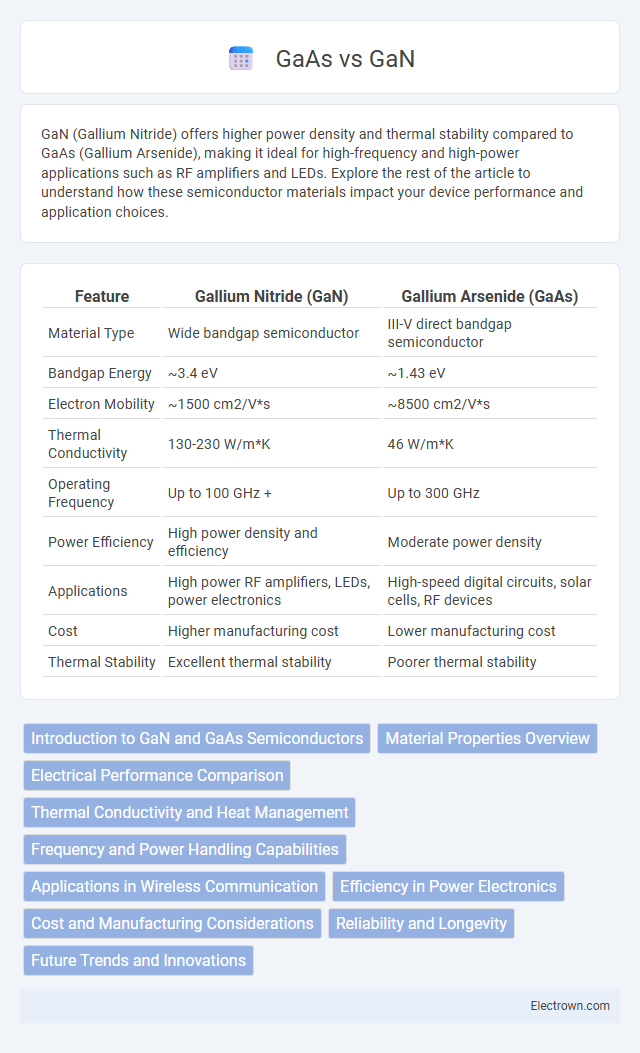GaN (Gallium Nitride) offers higher power density and thermal stability compared to GaAs (Gallium Arsenide), making it ideal for high-frequency and high-power applications such as RF amplifiers and LEDs. Explore the rest of the article to understand how these semiconductor materials impact your device performance and application choices.
Table of Comparison
| Feature | Gallium Nitride (GaN) | Gallium Arsenide (GaAs) |
|---|---|---|
| Material Type | Wide bandgap semiconductor | III-V direct bandgap semiconductor |
| Bandgap Energy | ~3.4 eV | ~1.43 eV |
| Electron Mobility | ~1500 cm2/V*s | ~8500 cm2/V*s |
| Thermal Conductivity | 130-230 W/m*K | 46 W/m*K |
| Operating Frequency | Up to 100 GHz + | Up to 300 GHz |
| Power Efficiency | High power density and efficiency | Moderate power density |
| Applications | High power RF amplifiers, LEDs, power electronics | High-speed digital circuits, solar cells, RF devices |
| Cost | Higher manufacturing cost | Lower manufacturing cost |
| Thermal Stability | Excellent thermal stability | Poorer thermal stability |
Introduction to GaN and GaAs Semiconductors
Gallium Nitride (GaN) and Gallium Arsenide (GaAs) are advanced semiconductor materials widely used in high-frequency and high-power electronic devices. GaN offers superior efficiency, higher breakdown voltage, and thermal stability, making it ideal for power amplifiers and RF components, while GaAs provides excellent electron mobility useful for fast digital circuits and optoelectronics. Understanding the distinct electrical and material properties of GaN and GaAs helps you choose the best semiconductor technology for your specific application needs.
Material Properties Overview
Gallium Nitride (GaN) exhibits a wider bandgap of approximately 3.4 eV compared to Gallium Arsenide (GaAs) with a bandgap of 1.42 eV, enabling higher voltage operation and superior thermal stability. GaN's higher electron mobility and saturation velocity contribute to enhanced high-frequency performance and power efficiency relative to GaAs. The robust mechanical and chemical properties of GaN also support applications in harsh environments, while GaAs remains favored for its mature fabrication technology and excellent electron transport in low-power, high-speed devices.
Electrical Performance Comparison
Gallium Nitride (GaN) exhibits superior electrical performance compared to Gallium Arsenide (GaAs), with higher electron mobility reaching up to 2000 cm2/V*s, enabling faster switching speeds and greater efficiency in high-frequency applications. GaN devices maintain higher breakdown voltages and exhibit lower on-resistance, resulting in improved power density and thermal performance essential for RF amplifiers and power electronics. Conversely, GaAs offers moderate electron mobility (~8500 cm2/V*s) but suffers from lower breakdown field strength, limiting its capability in high-power, high-frequency environments compared to GaN.
Thermal Conductivity and Heat Management
Gallium Nitride (GaN) exhibits significantly higher thermal conductivity, around 130-230 W/m*K, compared to Gallium Arsenide (GaAs), which typically shows thermal conductivity near 46 W/m*K, enabling more efficient heat dissipation in high-power applications. Enhanced thermal management in GaN-based devices reduces the risk of thermal runaway, improving reliability and performance in RF amplifiers and power electronics. Effective heat conduction in GaN allows for smaller, more compact device designs without compromising thermal stability, making it preferable for modern high-frequency and high-power semiconductor devices.
Frequency and Power Handling Capabilities
Gallium Nitride (GaN) exhibits superior frequency performance, efficiently operating at frequencies above 30 GHz, making it ideal for high-frequency applications like 5G and radar systems. GaN also boasts higher power handling capabilities with breakdown voltages exceeding 600 V, supporting high power density and thermal conductivity, which surpasses Gallium Arsenide (GaAs) performance. In contrast, GaAs is effective in moderate frequency ranges up to about 20 GHz but offers lower power efficiency and breakdown voltage, limiting its use in high-power, high-frequency scenarios.
Applications in Wireless Communication
GaN (Gallium Nitride) and GaAs (Gallium Arsenide) are critical semiconductor materials in wireless communication, with GaAs widely used in high-frequency applications such as RF front-end modules for smartphones due to its high electron mobility and excellent signal amplification. GaN is increasingly favored in power amplifiers and base stations because of its superior power density, efficiency, and thermal conductivity, enabling faster data transmission and improved network capacity. The combination of GaN's robustness in high-power environments and GaAs's efficiency in low-noise amplifiers supports advanced 5G and emerging 6G technologies.
Efficiency in Power Electronics
Gallium Nitride (GaN) outperforms Gallium Arsenide (GaAs) in power electronics due to its higher electron mobility and wider bandgap, enabling devices to operate at higher voltages, frequencies, and temperatures with greater efficiency. GaN power transistors exhibit lower on-resistance and reduced switching losses, which contribute to improved energy conversion efficiency and reduced heat generation in power systems. These characteristics make GaN the preferred semiconductor material for high-efficiency power converters and RF power amplifiers compared to GaAs-based devices.
Cost and Manufacturing Considerations
Gallium Nitride (GaN) devices generally offer lower manufacturing costs compared to Gallium Arsenide (GaAs) due to GaN's compatibility with more scalable and mature silicon substrate technologies. GaN production benefits from higher thermal conductivity and power efficiency, reducing packaging and cooling expenses, which directly impact overall cost-effectiveness. GaAs, while established in the semiconductor industry, faces higher material costs and complexity in substrate processing, leading to increased manufacturing expenses.
Reliability and Longevity
GaN (Gallium Nitride) semiconductor devices exhibit superior reliability and longevity compared to GaAs (Gallium Arsenide) due to their higher thermal conductivity and breakdown voltage, which reduce the risk of overheating and device degradation over time. GaN's robust crystal structure enables it to withstand higher electric fields and temperatures, resulting in longer operational lifespans in harsh environments. When choosing components for high-performance applications, your selection of GaN technology ensures greater durability and sustained efficiency.
Future Trends and Innovations
Gallium Nitride (GaN) is rapidly advancing in power electronics and RF applications due to its superior electron mobility and thermal conductivity compared to Gallium Arsenide (GaAs). GaN's potential for higher frequency operation and increased efficiency positions it as the preferred material for next-generation 5G networks, radar systems, and electric vehicles. Your choice between GaN and GaAs should consider GaN's scalability and future innovations that promise enhanced performance and lower manufacturing costs.
GaN vs GaAs Infographic

 electrown.com
electrown.com